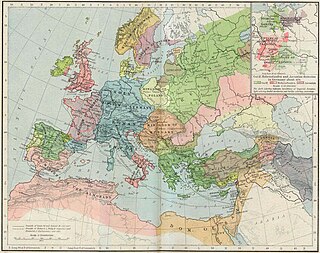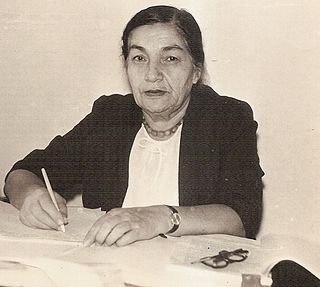
Nagorno-Karabakh, also known as Artsakh, is a landlocked region in the South Caucasus, within the mountainous range of Karabakh, lying between Lower Karabakh and Zangezur, and covering the southeastern range of the Lesser Caucasus mountains. The region is mostly mountainous and forested.

The Danishmend or Danishmendid dynasty was a Turkish Beylik that ruled in north-central and eastern Anatolia from 1071/1075 to 1178. The dynasty centered originally around Sivas, Tokat, and Niksar in central-northeastern Anatolia, they extended as far west as Ankara and Kastamonu for a time, and as far south as Malatya, which they captured in 1103. In early 12th century, Danishmends were rivals of the Seljuk Sultanate of Rum, which controlled much of the territory surrounding the Danishmend lands, and they fought extensively against the Crusaders.
The Armenian nobility was a class of persons which enjoyed certain privileges relative to other members of society under the laws and customs of various regimes of Armenia. Governments which recognized or conferred nobility were the Kingdom of Van, Satrapy of Armenia, ancient Kingdom of Armenia, Bagratid Kingdom of Armenia (885-1045) and the Armenian Kingdom of Cilicia (1198-1375). The Armenian kingdoms of Vanand (963-1065), Syunik (987-1170), and Lori (978-1113) had a system of nobility that was similar to the nobility of Cilicia.

Qazax is a city in and the capital of the Qazax Rayon of Azerbaijan. It has a population of 20,900.

Israel Ori (1658–1711) was a prominent figure of the Armenian national liberation movement and a diplomat that sought the liberation of Armenia from Persia and the Ottoman Empire.
Artsakh is located in the southern part of the Lesser Caucasus range, at the eastern edge of the Armenian Highlands, encompassing the highland part of the wider geographical region known as Karabakh. Under Russian and Soviet rule, the region came to be known as Nagorno-Karabakh, meaning "Mountainous Karabakh" in Russian. The name Karabakh itself was first employed in Georgian and Persian sources from the 13th and 14th centuries to refer to an Armenian principality known by modern historians as the Kingdom of Artsakh or Khachen.

Мelik was a hereditary Armenian noble title, in various Eastern Armenian principalities known as melikdoms encompassing modern Yerevan, Kars, Nakhichevan, Sevan, Lori, Artsakh, Northwestern Persia and Syunik starting from the Late Middle Ages until the end of the nineteenth century. After the invasions of the Seljuk Turks, Mongols, Timurlenk and Turkmen tribes these families saw themselves as holding onto the last bastion of Armenian independence in the region.

The Shah-Armens, also called the Kings of Armenia or Rulers of Ahlat, were the 11th- and 12th-century Turcoman rulers of an Anatolian beylik founded after the Battle of Manzikert (1071) and centred in Ahlat on the northwestern shore of the Lake Van. This region comprised most of Bitlis and Van provinces and parts of Batman, Muş, Siirt and Diyarbakır.

Tuğ is a village in the Khojavend Rayon of Azerbaijan and Hadrut Province of the Republic of Artsakh.
Hakop is a common Armenian first name, it's a cognate of English names Jacob or James. Etymologically speaking, the name dates back to various centuries B.C., and is strictly exclusive to the Armenian region and language.

Rouben Melik was a French-Armenian poet and a member of the French Resistance. Officer of Ordre des Arts et Lettres (1963).
The Five Melikdoms of Karabakh, also known as Khamsa Melikdoms, were Armenian feudal entities that existed on the territory modern Nagorno Karabakh and neighboring lands from the times of the dissolution of the Principality of Khachen in the 15th century and up to the abolition of ethnic feudal formations in the Russian Empire in 1822.

Ioan Mire Melik, or Melic, was a Wallachian, later Romanian mathematician, educator and political figure, one of the early members of Junimea literary society. Known for his work in private education, and for his tenure at the University of Iași, he was the author of several early introductions to science—dealing with arithmetic and geometry, but also with topography and surveying. He was perceived as a bland figure at Junimea meetings, and had little to do with its literary agenda, but took care of administrative chores and, for a while, of its publishing venture.
Harutyun also spelled Haroutioun, Harutiun and its variants Harout, Harut and Artin is a common male Armenian name; it means resurrection in Armenian.

Natalya Melik Melikyan was an Armenian scientist.
Nizamettin Yağıbasan, or simply Yağıbasan was the sitxh ruler of Danishmendids and the uncle of Melik Zünnun.
Rafi' or Raffi is a name of Arabic origin is one of the names of God in Islam, stemming from the Arabic verb rafaʿ (رَفَع), meaning "to lift, to raise ". maybe also rafi means "noble". There are two common known variants of the name:
Melik Mehmed Gazi, was the fourth ruler of Danishmendids.
Emir Gazi or known as Emir Melikgazi was the third ruler of Danishmendids and the elder son of Gazi Gümüshtigin.
Melik Zünnun was the fifth ruler of Danishmendids.









